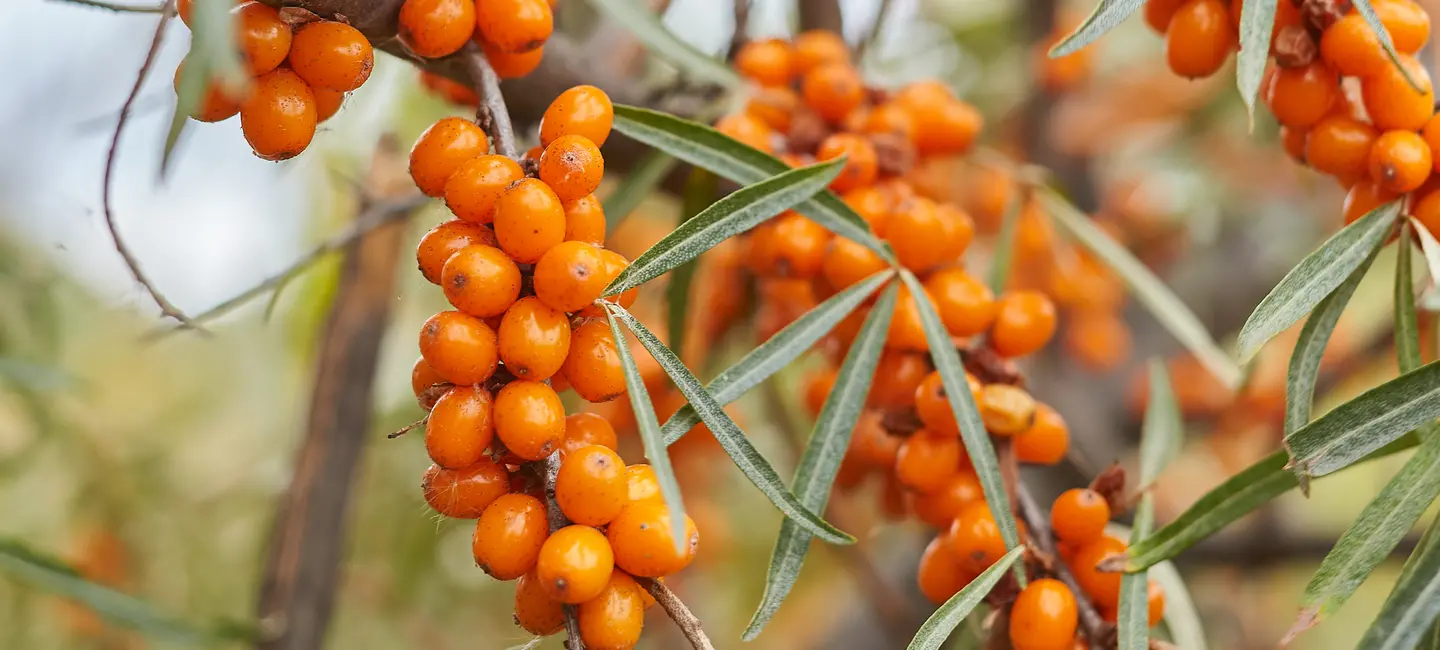
Sea buckthorn (Hippophae rhamnoides) is a plant found throughout Europe and Asia. The leaves, flowers, seeds, and fruits are used as medicine.
Sea buckthorn contains vitamins A, B1, B2, B6, and C, as well as other active ingredients. It's been used traditionally to slow down the aging process.
People use sea buckthorn for burns, eczema, acne, indigestion, high blood pressure, wrinkled skin, and many other purposes, but there is no good scientific evidence to support most of uses.
Don't confuse sea buckthorn with other plants known as "buckthorn," including alder buckthorn, European buckthorn, and Cascara sagrada. These are not the same.
Is It Effective?
NatMed Pro rates effectiveness based on scientific evidence according to the following scale: Effective, Likely Effective, Possibly Effective, Possibly Ineffective, Likely Ineffective, Ineffective, and Insufficient Evidence to Rate.
- Burns. Applying a sea buckthorn cream seems to help burns heal faster.
- Eczema (atopic dermatitis). Neither taking sea buckthorn by mouth nor applying a sea buckthorn cream to the skin seems to help eczema.
There is interest in using sea buckthorn for a number of other purposes, but there isn't enough reliable information to say whether it might be helpful.
Is it Safe?
When taken by mouth: Sea buckthorn fruit is commonly consumed as food. Sea buckthorn fruit is used in jams, pies, drinks, and other foods. The oil extract of sea buckthorn fruit and seed is possibly safe when used for up to 90 days. There isn't enough reliable information to know if sea buckthorn leaf or leaf extracts are safe or what the side effects might be.
When applied to the skin: Sea buckthorn fruit is possibly safe when used in a cream for up to 13 days. It might cause red or itchy skin for some people.
Special Precautions & Warnings:
Pregnancy and breast-feeding: There isn't enough reliable information to know if sea buckthorn is safe to use when pregnant or breast-feeding. Stay on the safe side and stick to food amounts.
Children: Sea buckthorn is possibly safe when taken by mouth for up to 8 weeks in children 1-7 years of age.
Bleeding disorder: Sea buckthorn might slow blood clotting when taken as a medicine. It might increase the risk of bruising and bleeding in people with bleeding disorders.
Surgery: Sea buckthorn might slow blood clotting when taken as a medicine. It might cause extra bleeding during and after surgery. Stop using sea buckthorn at least 2 weeks before a scheduled surgery.
Medications for high blood pressure (Antihypertensive drugs)
Interaction Rating=Moderate Be cautious with this combination.
Sea buckthorn might lower blood pressure. Taking sea buckthorn along with medications that lower blood pressure might cause blood pressure to go too low. Monitor your blood pressure closely.
Medications that slow blood clotting (Anticoagulant / Antiplatelet drugs)
Interaction Rating=Moderate Be cautious with this combination.
Sea buckthorn might slow blood clotting. Taking sea buckthorn along with medications that also slow blood clotting might increase the risk of bruising and bleeding.
Herbs and supplements that might lower blood pressure: Sea buckthorn might lower blood pressure. Taking it with other supplements that have the same effect might cause blood pressure to drop too much. Examples of supplements with this effect include andrographis, casein peptides, L-arginine, niacin, and stinging nettle.
Herbs and supplements that might slow blood clotting: Sea buckthorn might slow blood clotting and increase the risk of bleeding. Taking it with other supplements with similar effects might increase the risk of bleeding in some people. Examples of supplements with this effect include garlic, ginger, ginkgo, nattokinase, and Panax ginseng.
There are no known interactions with foods.
Sea buckthorn has been used in extracts, fruit purees, seed oils, pulp oils, creams, and sprays. There isn't enough reliable information to know what an appropriate dose of sea buckthorn might be. Keep in mind that natural products are not always necessarily safe and dosages can be important. Be sure to follow relevant directions on product labels and consult a healthcare professional before using.
Ananas de Sibérie, Argasse, Argousier, Argousier Faux-Nerprun, Bourdaine Marine, Buckthorn, Chharma, Dhar-Bu, Épine Luisante, Épine Marrante, Espino Armarillo, Espino Falso, Faux Nerprun, Finbar, Grisset, Hippophae rhamnoides, Meerdorn, Oblepikha, Olivier de Sibérie, Purging Thorn, Rokitnik, Sallow Thorn, Sanddorn, Saule Épineux, Sea Buckhorn, Sceitbezien, Sea-Buckthorn, Seedorn, Star-Bu, Tindved, White Sea Buckthorn.
Information on this website is for informational use only and is not intended to replace professional medical advice, diagnosis, or treatment. While evidence-based, it is not guaranteed to be error-free and is not intended to meet any particular user’s needs or requirements or to cover all possible uses, safety concerns, interactions, outcomes, or adverse effects. Always check with your doctor or other medical professional before making healthcare decisions (including taking any medication) and do not delay or disregard seeking medical advice or treatment based on any information displayed on this website.
© TRC Healthcare 2024. All rights reserved. Use and/or distribution is permitted only pursuant to a valid license or other permission from TRC Healthcare.
